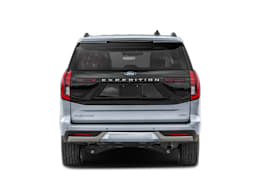Introduction
2025 Ford Expedition Shines With a Potent Powertrain, Cool Tech, and Interior Innovations
But the oblong steering wheel and some controls have us scratching our headsOverview
We have completed testing of the Expedition. Stay tuned for the full road-test report.
The aptly named Ford Expedition isn’t made for solo hiking; it was crafted for adventuring with the whole family or team. Revamped for 2025, the fifth-generation Expedition is more capable and packed with more convenience features than ever before.
It is once again offered in two lengths. The standard version measures almost 210 inches bumper to bumper, and the Max is stretched out to almost 222 inches, with a 9-inch longer wheelbase, for buyers who need to maximize cargo space. (The size essentially didn’t change from the previous generation.)
The revitalized Expedition comes to market alongside the redesigned Lincoln Navigator, which pushes some technology boundaries even further. It faces established rivals, such as the Chevrolet Tahoe/Suburban and Toyota Sequoia, but also the Jeep Wagoneer and redesigned Nissan Armada. Shoppers looking for a full-sized SUV have some compelling choices to consider.
Four trims are available for the Expedition: Active, Platinum, Tremor, and King Ranch. Each is available in the standard and Max sizes, except for the Tremor. In keeping with its mission to traverse off-road trails, it’s limited to the standard size.
Serving as the entry point, the eight-passenger Active has all the space, capability, and power expected in a full-sized SUV, though it holds back on some creature comforts to keep the price down, as evidenced by the cloth seats. It does pack a mighty 400-horsepower twin-turbo V6 engine. A long list of options enables buyers to add numerous upgrades.
The “Platinum” name evokes images of the upper echelon of a model range, but here, it layers in many popular features on this second-tier version while leaving room for even more exclusive configurations. In buying a Platinum for testing, we stuck with the 400-hp engine, although a 440-hp engine is optional. This seven-passenger trim comes with leather, BlueCruise hands-free driver assistance, and many other niceties.
New to the Expedition line, the Tremor is an off-road version, packing the more powerful engine, fortified suspension with 10.6 inches of ground clearance (almost 2 more than the Platinum version), 18-inch wheels with 33-inch all-terrain tires, off-road lights, and numerous leather, badging, and stitching embellishments.
The extroverted King Ranch is the best-equipped trim, with bronze wheels and accents, badged leather seats, and every feature in the Expedition catalog. Where the Active may be for the ranch hand and their, uh, active family, the King Ranch is for the cattle baron.
This mammoth machine packs a veritable truckload of active safety and driver assistance features as standard equipment. Given its size, many of these systems—such as the surround view camera, automatic emergency braking, blind spot warning, rear cross traffic, and lane keeping assistance—are especially appreciated. There are also clever systems to make it easier to connect a trailer and even backup with one attached like a pro. Clearly, there’s a lot to unpack here. So let’s get started.
We bought a Platinum AWD version for testing. With a few options, the total MSRP came to $79,995.
The final assembly plant is in Louisville, Kentucky.
It competes with the Chevrolet Tahoe/Suburban, GMC Yukon/Yukon XL, Jeep Wagoneer, Nissan Armada, and Toyota Sequoia.


























